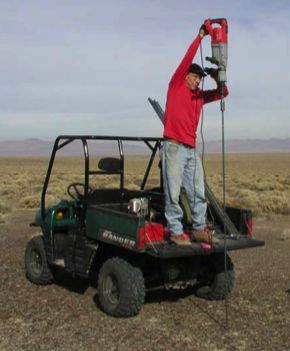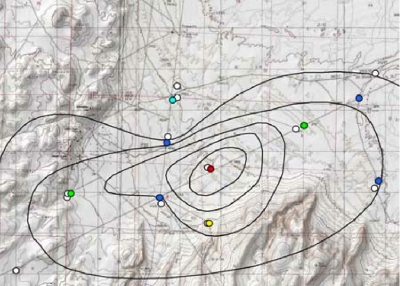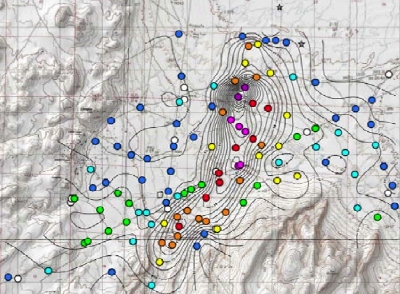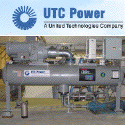Blog Archives
Ecologically sound network hosting
A former Sun colleague, Jon Greaves, sent me this article a few days ago:
Norfolk Wildlife Trust now has an environmentally friendly
website, after a move this week to solar powered hosting.
Athenaeum who run EcologicalHosting.com are the only UK
based company to have an entire hosting infrastructure
powered from renewable energy sources, making it
low-impact on the environment.Their main hosting is housed in a data centre in California.
Electricity from 120 solar panels capable of generating up
to 60 kilowatts of electricity per day provides all the power
for data centre offices, air conditioners and all computer
equipment.By choosing to host their website with them, NWT is making
a commitment to the environment to protect the future.
Normal data centres obtain their main power from the local
grid supply, using up very large amounts of electricity that
has been generated from non-renewable sources such as coal,
gas or nuclear power stations. Solar hosting plays its part to
help prevent global warming, and so helps to preserve the
natural habitat of animals around the world.Director of Athenaeum Jamie Simpson commented:
‘EcologicalHosting.com welcomes Norfolk Wildlife Trust to
our solar powered Internet service. Along with our other
clients they are showing the world that they care about the
environment and also making a statement that many
traditionally power hungry services like web hosting do
have viable environmentally friendly alternatives available.’Director of Norfolk Wildlife Trust Brendan Joyce commented:
‘We are delighted to move our website to
EcologicalHosting.com, as it is another way of reducing
our impact on the environment. Our website has plenty
of information on wildlife and caring for the environment,
and now our website hosting matches our green philosophy.”
I found this fascinating and believe we’ll see more of this type of company. Power consumption is one of the largest expenses for hosting providers and when they can tap into renewables where the fuel is free, there’s a real competitive advantage to be had over the long haul. Another opportunity I see clearly is harvesting the tens of millions of btus that are exhausted from data centers. It’s not yet clear what the 20-25C resource is good for, but the person or persons who crack that nut will be very rich…
If you liked this entry, Digg It!
Technorati Tags: Eco Hosting | Renewable Energy | Solar
Finding geothermal resources
If you wondered why there weren’t more geothermal projects, you’re not alone. One of the more vexing things about geothermal resources is finding them. When compared with other renewable resources it’s a much more challenging endeavour. After all, it’s pretty evident how to determine if a site is appropriate for wind or solar generation by monitoring the wind speed and sunlight in potential site areas. While there is definitely science involved, a layperson can do a pretty good job in suggesting sites.
Geothermal, not so much. There are some obvious signs that a geothermal system is at work, these include volcanos, faults, geysers, hotsprings, fumaroles, travertine deposits, and tufa towers. But none of these indications necessarily mean that an area is productive, just clues that they might be productive. So, how does one “discover” and then qualify a geothermal resource?
The answer is that aside from obvious vulcanism and spewing hot water on the surface, to date, most areas are discovered as an unwanted side effect of another activity, like mining or drilling for petroleum. In other words, geothermal finds tend to be the result of serendipidous accidents or stunningly obvious features observed on the surface. The majority of geothermal resources however are called “blind” resources – that is, there is little if any indication on the surface of the earth that a particular spot might house a geothermal resource. Which begs the question: how does one go about specifically looking for geothermal resources and then qualifying them? Particularly “blind” resources (as most of the obvious surface indicated resources have been tapped or protected – like Yellowstone Park’s geysers.)
At the Stanford Geothermal conference yesterday, there were several approaches to find “blind” geothermal resources presented. Most of these have been around for awhile that are increasingly useful in indicating where one might choose to invest serious money to drill a test well. For those who aren’t familiar with the drilling industry, these holes cost a few million dollars to drill. Thus, you want to be pretty sure you’re in an area that will produce before breaking ground.
Of the approaches including thermal imaging, gravity measurements, magnetic resonance, electrical resistance, and shallow temperature prospecting, the shallow temperature approach seems to be the best tool from my perspective. Effectively, this is a method of drilling 2 meter holes in a grid, measuring the temperature at depth, and factoring the surface trends to get a data set. Mark Coolbaugh presented this talk yesterday of a test he performed in the Desert Peak area in Nevada. The results were impressive and interesting as this is a known geothermal production area – even potentially uncovering further resource in the Desert Queen area.
The way it works is dead simple. A grid is laid out over an interesting area, at periodic intervals (every x meters for instance) a 2 meter deep hole is created with a special, hollow steel drill bit attached to an electric hammer drill. It takes a few minutes to drive this into the ground. Once secured, a temperature probe is dropped down the center of the bit and after an hour passes or so, the temperature is taken. The hour was derived by testing to see how quickly a hole returned to base temp state after digging. Instead of having a few measurements available over a large area with huge costs – even 60M “slim holes” for temperature gradient are expensive – one gets a large number of measurements over the same area.
Driving bit into the ground

Desert Queen – 9 Temperature Gradient Wells with 2m temps overlayed. Note, the whites are the temperature gradient wells, the blues are “cold” and the yellows, oranges, and reds are “hot.” As you can see, there is an assumption made about the resource size and shape with the contour lines.

Desert Queen – All 2m data points (and temperature gradient wells.) As you can see, the 9 data point model badly misconstrued the size and shape of the potential resource. The contour lines are 1 degree C differences and at 2m the delta T between “background” and “hot” was greater than 20 degrees C.

This particular approach does have limitations in that shallow aquifers or wet ground will impede the accuracy of the method, but considering the vast majority of geothermically active area in the US is located in arid climates, this isn’t such a barrier to use. Of course, the most effective way (and only way) to truly qualify a resource is through drilling and flow testing of the geothermal resource. At present, drill rig rental runs around $22,500 per DAY – without the crew and that’s if you can even find a rig to rent. It’s an expensive undertaking to be sure. But a simple, relatively cheap, and relatively fast way to profile a large area is using this shallow temperature approach. It seems to work and should be a valuable tool in the geothermal prospector’s portfolio.
The summary is that there are many methods to find “blind” resource and we’re constantly getting better at it. Another question is, who is actually looking for such resources? The only answer I can provide at present is virtually no one.
If you liked this entry, Digg It!
Technorati Tags: Discovery | Blind | Geothermal
Just how much geothermal potential is in the US?
This is a question bandied about frequently in geothermal circles. Recently, a panel chaired by Jeff Tester from MIT set out to answer that question and they presented their results at the 32nd Stanford Geothermal Conference yesterday.
Let’s first setup the measurement system, it’s in exa-joules (EJ.) A kilowatt hour is approximately 3.6M joules. An exa-joule is 10 to 18th power joules, or 1,000,000,000,000,000,000 joules. The entire US electric consumption for a year is around 100 EJ. Now that this is a nice easy way to think of it, 1 EJ = 1% of annual US electricity consumption, I’ll tell you what they discovered.
That if only 2% of the US geothermal potential was tapped, we would be able to access some 28,000 EJ in electric power generation. This statement is grand and requires some explanation. There are two flavors of geothermal power, hydrothermal and enhanced or engineered geothermal systems. This combines the output of both methods and predicts that resources at deep as 10km will be exploited over the next 50 years.
Even if this estimate is wrong by two orders of magnitude, it’s still 28x our current annual electricity consumption for the entire country. That is sufficient to cause even the most jaded person to stop and think. What could we achieve if we diligently work to tap and harvest this resource inside our own borders, with no carbon emission, and maintain our energy system with baseload power? What’s the impact of simply displacing old coal plants with new geothermal plants?
The study goes on to say that they believe 100,000 MWe (generation capacity) is entirely feasible by 2050, which is only 10% of the current electricity consumption per year in the US. There’s now a nice article posted on the MIT website that references this study available here.
I’ve said it before and I’ll say it again, each megawatt hour of electricity generated by burning coal yields a ton of carbon and 14 kg of SOx and NOx into the atmosphere. To produce a new “clean” coal plant is a $1B+ investment. Fuel cost of coal has increased 35% over the past 6 years. Our ability to transport new coal in the US is constrained by railroad capacity, which is at capacity. Why invest in coal now?
Why not invest in clean power generation where the fuel is free and local. Nothing gets vented into the atmosphere (in a closed system) and start solving our dependence and climate impact. This isn’t rocket science….
If you liked this entry, Digg It!
Technorati Tags: Geothermal | Potential | EGS
Attack fossil funding
Not a bad ploy really. The Boston Globe reports that a coalition of environmental groups are doing just that as the Texas Utility Corporation (TXU) seeks $11B for funding the construction of 11 new pulverized coal plants which would release some 78 million tons of carbon monoxide into the atmosphere per year.
What else could one do with $11B of investment? Here’s a list:
- Add 3,600 MW of geothermal power generation (note, this would increase the US geothermal production by 164%) – or –
- Add 9,200 MW of wind power generation (and one could do this in Texas) – or –
- Add 1,375 MW of solar power generation (this could work in Texas too) – or –
- Or if one must do fossil fuel, add 14,600 MW of natural gas power generation
Yes, coal is relatively speaking cheap to acquire, transport, and use. But the cost of the atmospheric impact is huge. Until and unless coal burners have to pay that cost, the true economic impact isn’t being factored in. Even with that, coal prices are up 35% this decade and the rail lines are at (or over) capacity to transport it from point A to point B. Sooner or later, the fact that the fuel is free will make the economics of renewable power generation too attractive to pass up. The environmental benefit will be a nice synergistic effect.
If you liked this entry, Digg It!
Technorati Tags: Coal | Electricity | Funding
Suicide by Coal
According to the American Heritage Dictionary, a suicidal act is one that is “dangerous to oneself or to one’s interests; self-destructive or ruinous.” By this standard, the coal boom that is currently sweeping America is the atmospheric equivalent of a swan dive off a very tall building. At precisely the moment that scientists have reached a consensus that we need to drastically cut climate-warming pollution, the electric-power industry is racing to build more than 150 new coal plants across the United States. Coal is by far the dirtiest fossil fuel: If the new plants are built, they will dump hundreds of millions of tons of carbon dioxide into the atmosphere each year for decades to come — virtually guaranteeing that the U.S. will join China in leading civilization’s plunge into a superheated future.
That’s a quote straight from Jeff Goodell contributor to Rolling Stone magazine. Now I know there are technologies (gasification for instance) that can make coal cleaner than it has been, but that’s still orders of magnitude more polluting than renewable options available. What if, instead of doing “the easy thing” of investing in more coal plants we did “the right thing” and rechanneled that money into renewable plants (a mix of geothermal, wind, biomass, and solar?)
Here’s the thing, according to the US Department of Energy, for each 1,000,000 kwh (1 MWh) of electricity generated by burning coal, 1,000 kg of carbon and around 14 kg of NOx and SOx are released into the atmosphere. Let’s say we make coal 50% less polluting, great. But that would still result in 507 kg of pollutants produced per MWh.
We’re obviously not as smart as we purport to be…
If you liked this entry, Digg It!
Technorati Tags: Energy | Pollution | Coal








